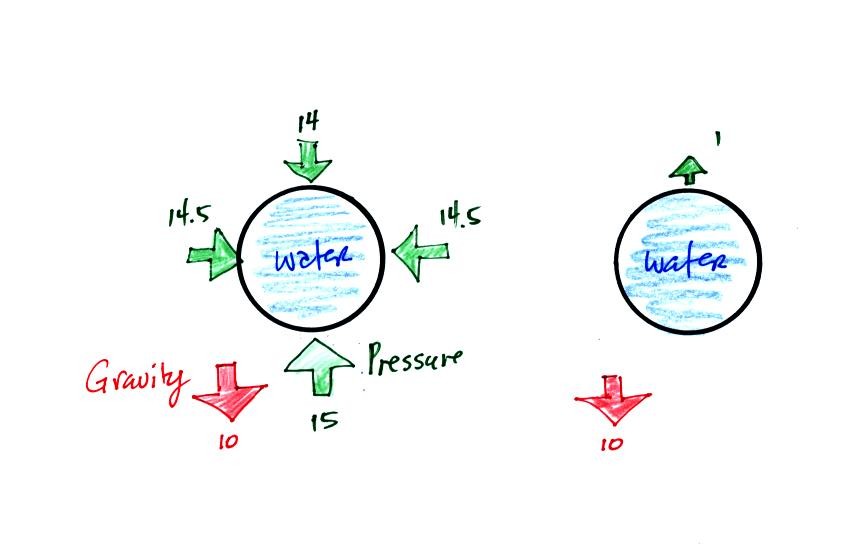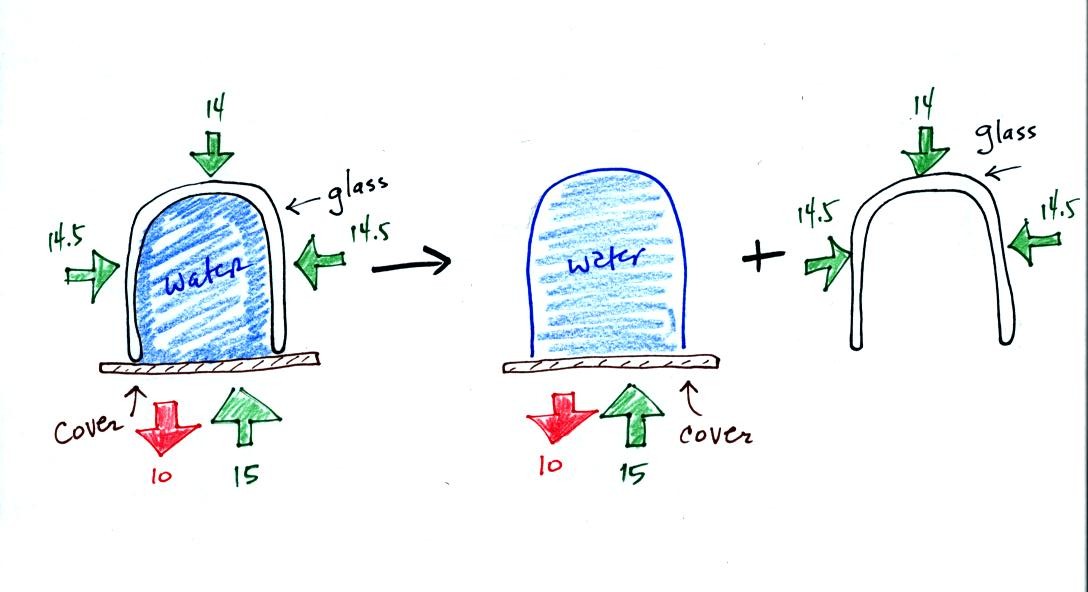Fri., Jan 27, 2006
Don't forget the Assignment #1 1S1P reports
are due on Monday.
There is an optional assignment due
next Wednesday. The Practice Quiz is also next Wednesday.
The reviews for the Practice Quiz will all be held in Chavez 301.
Dates and times of the reviews are on the Practice
Quiz Study.

This is page 26 in the photocopied notes redrawn on a blank
sheet of paper.
As you move upward from the ground pressure decreases by 100 mb in both
figures. Both layers contain the same amount of air (10% of the
air in the atmosphere). That air is found in a smaller volume in
the figure at left (the layer is thinner). This means the air at
left is denser than the air at right. The drop in air pressure in
the layer at left occurs in a shorter vertical distance than in the air
layer at right. That is a more rapid rate of pressure decrease
with distance than in the layer at right.
The rate of pressure decrease
with altitude is higher in the dense air at left than in the lower
density air at right.
This is a fairly subtle but important concept. We will use it
when we try to understand the intensification of hurricanes later in
the semester.

Air pressure is a force that pushes downward, upward, and
sideways.
The bottom person in the people pyramid below must push upward with
enough
force to support the other people. The air
pressure in the four tires on your automobile push down on the road
(you would feel that if the car ran over your foot) and push upward
with enough force to keep the 1000 or 2000 pound vehicle off the
road.


I am going to redraw the two figures from p. 35 in the
photocopied
notes that described the class demonstration of upward air pressure
force. Hopefully this will make for a clearer explanation of the
demonstration.

At left, gravity, the red arrow, pulls downward on the water
balloon. The 10 is the strength of the gravitational force (I
just made this number up, don't worry about the units either).
Air pressure pushes upward on the bottom of the balloon with strength
15, slighly weaker forces (14.5) push sideways, and at the top of
the balloon air pressure pushes downward with strength 14.
Pressure decreases with increasing altitude, that is why the pressure
forces get weaker as you move from the bottom to the top of the
balloon.
Notice the two sideways forces cancel each other out. The upward
pointing pressure force is slightly stronger than the downward pressure
force. They don't quite cancel each other out, you are left (as
shown in the figure at right) with an upward pointing pressure
difference force of strength 1. Gravity (10) is stronger than the
pressure difference force (1) and the water balloon falls.
Now we'll look at the situation for the water in an upside down wine
glass

The figure at left shows the wine glass (the stem of the
glass has been
left off the drawing), the plastic cover, and the pressure and gravity
forces.
You can split this into two parts: (1) gravity pulling downward
and the pressure force pushing upward on the cover and water in the
glass and (2) the pressure force pushing downward and sideways on the
glass (which the instructor was holding in his hand). Now
notice that the 15 unit pressure force pushing up on the water is
greater than the 10 units of gravity pulling downward. The upward
pressure force now can keep the water from falling out of the glass.
Here's another situation where pressure and gravity forces are battling
each other for dominance, a balloon.

This is like a water balloon except that the balloon is now
filled with
a gas like air or helium. This gas is much lighter than
water. The gravity force will be much weaker and the upward
pressure difference force (the difference between the upward point
force at the bottom of the balloon and the downward pointing force at
the top of the balloon) will sometimes end up stronger than gravity.

Three layers of air in the atmosphere are shown above (each
layer
contains the same amount of air, 10% of the air in the
atmosphere). The layer at the ground and at the bottom of the
atmosphere is "squished" by the weight of the air above.
Squeezing all of this air into a thin layer or small volume increases
the air's density.
The next layer up is also squished but not as much as the bottom
layer. The density of the air in the second layer is lower than
in the bottom layer. The air in the 3rd layer has even lower
density. It is fairly easy to understand that air density
decreases with increasing altitude.
This figure also reminds you that air pressure decreases with
increasing altitude.
If you look carefully you see again that the most rapid rate of
pressure decrease with increasing altitude occurs in the thin layer of
high density air next to the ground.







